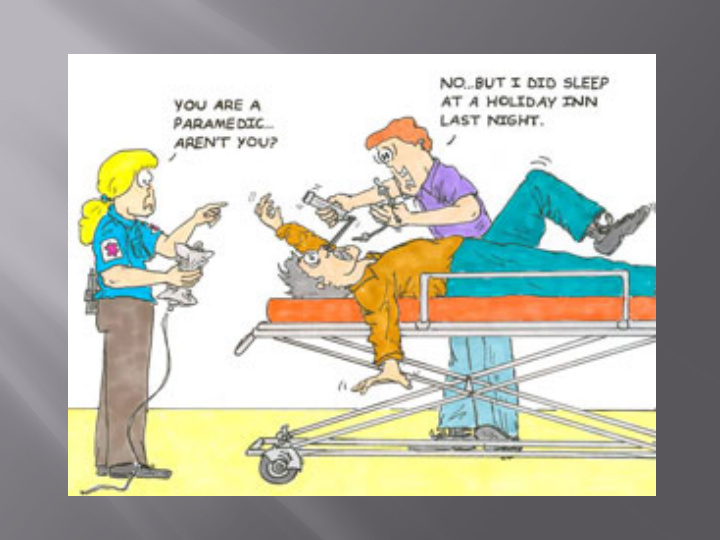



Presented by: Jim Fox EMT-PS EMS-I EMS Assistant Coordinator Des Moines Fire Department
� History � Controversies � Airway Management � King � Combi-Tube Easy Tube � � ETI � Instructions for use � Anatomy of King airway � Basic instructions � King Training Issues � Questions
� Invented by VBM of Germany 1998 � Introduced to the European market in 1999 � Introduced to USA in February 2003 � King Systems Corporation (USA) � Global leader in the anesthesia and respiratory care � FDA 510(k) certified for LT, LTD, & LTS � 2006 IDPH/EMS approves a 12 month study � Rural county hospital based service, population approxamately12,000 � Outcome positive and approved for all levels
� Warning letter to King Systems from FDA 10-26-09 � http://www.fda.gov/ICECI/EnforcementActions/ WarningLetters/ucm191860.htm � King LT(S)-D™ Airway - Instructions For Use available on your website states that the "KING LTS-D is intended for airway management in patients over 4ft in height for controlled (30 cm H²0 or higher) or spontaneous ventilation. It is also indicated for difficult and emergent airway cases and is well suited for ambulatory and office-based anesthesia." This represents a major change or modification in the cleared intended use of the device and requires a new 510(k).
� Response from King Systems to FDA 12-4-09 � http://www.kingsystems.com/Default.aspx?tabid= 257
Dr. Kupas, the Commonwealth, PA EMS � Medical Director. "The published and anecdotal information � related to the use of the King LT in EMS systems by ALS providers, in PA and other states, has been overwhelmingly positive, and we would likely be doing our patients a disservice by banning this device based upon its level of FDA approval".
� Excerpt from JEMS October 2008 “From the battle fields to our streets” article. � “The Army evaluated several devices and chose two: the dual-lumen Combi-Tube and the single-lumen King LT-D. Of these two devices, the King LT-D demonstrated a distinct advantage in terms of rapid, correct insertion over the Combi-Tube. Training novice users to correctly employ the King LT-D was easier, and the skill was retained for a longer period of time than with the Combi-Tube.”
� King – classed as an OPA � 1999 FR to PS providers can use � Single or double lumen � One syringe to inflate cuffs � At present three different sizes readily available � No medication route � Ability to insert ET using Bougie through King airway � Easy to use
� Combi-tube – classed as a double lumen blind intubation device � At present 1999 FR’s to PS providers can use � National EMS Education Standards Not listed in Psychomotor skills for EMR and EMT � Only OPA and NPA listed � Double lumen � Need to inflate two different cuffs � Two different sizes � No medication route � ET possible with devise in place � Easy to use
Easy Tube (EzT Rusch � Medical) � Introduced in USA January 2005 � Double lumen � 1999 FR to PS can use � Can be used as endotracheal or supraglottic airway � Not much known and further studies needed to compare to other airways � Can be used with fiber- optics
� ETI � Iowa - only EMT-P and PS can perform � Single lumen � Multiple sizes � Vocal cord visualization � Higher level of training required � Protects from gastric aspiration � Medication route � Gold standard of airway management
� Always use manufactures steps to insert � Following insertion steps lessens the chance of in- correct placement Instructions can be found on King Systems web site: http://www.kingsystems.com/EDUCATION/Instr uctionsforUse/Airways/tabid/129/Default.aspx http://www.kingsystems.com/PRODUCTS /AirwayDevices/KINGLTD/tabid/55/Default .aspx
� STEP 1: Hold the KING LT(S)-D at the connector with dominant hand. � With non-dominant hand, hold mouth open and apply chin lift, unless contraindicated by C-spine precautions or patient position. Using a lateral approach, introduce tip into corner of mouth.
� STEP 2: Advance the tip behind the base of the tongue while rotating tube back to midline so that the blue orientation line faces the chin of the patient.
� STEP 3:Without exerting excessive force, advance tube until base of connector is aligned with teeth or gums.
� STEP 4: Inflate cuffs to 60 cm H2O or to “just seal” volume. Typical inflation volumes are as follows: � KING LT-D: Size #3, 45-60 ml; Size #4, 60-80 ml; Size #5, 70-90 ml. � KING LTS-D: Size #3, 40-55 ml; Size #4, 50-70 ml; Size #5, 60-80 ml.
� STEP 5: Attach the breathing circuit/resuscitator bag to the KING LT(S)-D. While gently bagging the patient to assess ventilation, withdraw the KING LT(S)-D until ventilation is easy and free flowing (large tidal volume with minimal airway pressure).
� STEP 6: If necessary, add additional volume to cuffs to maximize seal of the airway.
� STEP 7: When utilizing the KING LTS-D’s gastric access lumen: Lubricate gastric tube (up to an 18 Fr) prior to inserting into KLTSD’s gastric access lumen.
� DO NOT insert as you would a Combi-Tube! � Must know airway anatomy � Continue training and practice � Don’t think that you can do it once and then be able to do it months later � Practice like your going to play � Contraindications � Gag reflex � Esophageal diseases � Caustic ingestion
� Remember to use capnography � Can be used with ResQPOD � Practice using Bouige with King for ETI
� When things go wrong!
� When thing really go wrong again!
� Possible causes of bent King � Inserted like a Combi-Tube � No lubrication � Met resistance and kept pushing � Able to recreate while inserting like Combi- Tube and resistance � Both possible causes to bent King airway � Unable to confirm exact cause of either � Remediation and follow up for both crews
� EMS Education Standards � http://www.nhtsa.gov/staticfiles/DOT/NHTSA/e ms/811077a.pdf � Iowa Department of Health Bureau of EMS � http://www.idph.state.ia.us/ems/
Recommend
More recommend